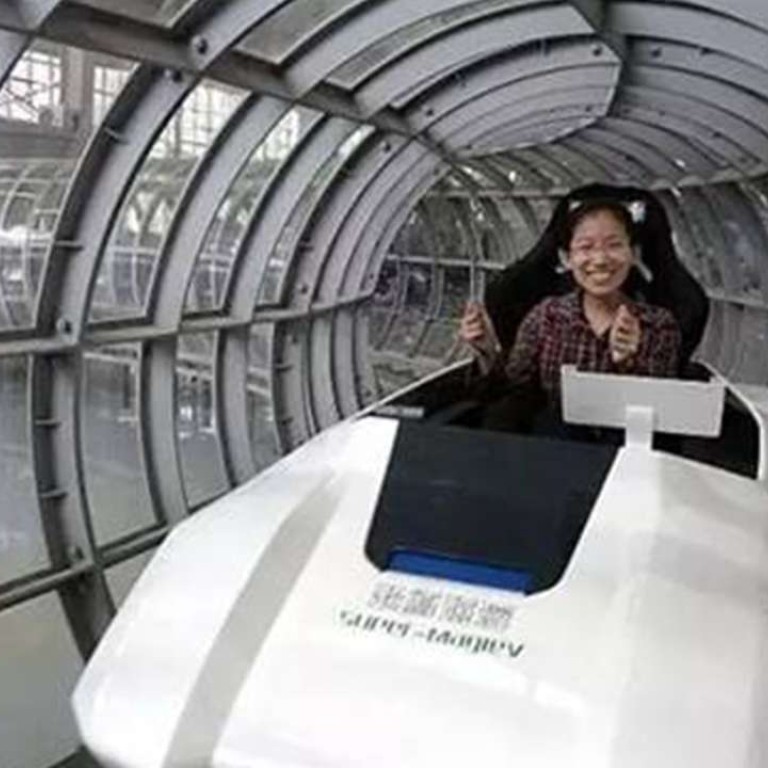
Beyond Hyperloop: Chinese scientists board ‘vacuum train’ for possible military projects
China’s scientists are looking to develop military applications for experimental technology behind an ultra high-speed “vacuum” transport system, according to a researcher involved in one of the projects.
The technology under development would involve loading passengers into pods and projecting them through vacuum tubes at high speeds.
The researcher said some of the work being done in China and the US was funded by the military as the technology might have defence applications.
A US team developing the technology carried out a test in the Nevada desert earlier this month.
A basic prototype “hyperloop” vehicle was fired along an open-air track and reached 187 km/h just 1.1 seconds after launch.
Billionaire Elon Musk unveils futuristic ‘Hyperloop’ transport plan
The American inventor and entrepreneur Elon Musk pitched the idea three years ago to develop the technology. His aim is to reach 1,000 km/h, which would allow people to travel from San Francisco to Los Angeles in about 30 minutes.
One centre researching the technology in China is State Key Laboratory of Traction Power at Southwest Jiaotong University in Chengdu (成都) in Sichuan (四川) province.
One of the team, Professor Zhao Chunfa, said he was not impressed with the trial in the US.
“On a straight rail several kilometres long we can accelerate to over 1,000km/h without much difficulty using existing technology,” he said.
Zhao is a senior scientist developing a high-speed train operating in a vacuum. It will use magnetic levitation, or “maglev” technology, to raise the vehicle above a track and reduce friction.
Construction of an experimental track is at the planning stage, according to the website of the Superconductivity and New Energy Research and Development Centre at the university.
The (very) fast track: Hyperloop’s first test bodes well for 1,100km/h transit system
Numerous research teams are developing the technology in China and some of the projects have not been disclosed to the public due to their military sensitivity, according to Zhao. “The situation is similar in the US. A major drive for the research comes from military demand,” Zhao said.
The PLA is interested in vacuum train technology for several reasons, according to Zhao. Launching a missile from a vacuum tube, for instance, could reduce its fuel consumption by 60 per cent to 70 per cent, he said. That meant a missile could fly much further or carry more warheads.
Zhao said vacuum train technology could also be used to launch fighter jets on aircraft carriers.
Some research teams were also conducting experiments to send small military satellites into orbit from a vacuum tube, he said.
Another area under intensive research is to combine the vacuum tube with a railgun.
A railgun uses electromagnetic forces to destroy a target with high energy particles and vacuum train technology may make it easier to accelerate projectiles to extremely high speeds, according to a Chinese researcher in the field.

China and the US are taking different approaches to develop the technology, according to Zhao.
Most Chinese researchers used maglev systems to lift the vehicle into the air to avoid physical contact with the rail, which would generate enormous friction and heat at high speed.
The maglev approach is less popular in the US, according to Zhao.
The hyperloop capsules proposed by Musk levitate on pressurised air generated by compressors under the vehicles. The capsules were driven forward by powerful magnetic fields generated by linear induction motors along the track, he said.
Even Elon Musk was unsure if SpaceX landing would be successful
Maglev technology was more expensive, while pressurised air was more difficult to control, but both technologies needed to overcome a long list of challenges before finding an application in the real world, Zhao said.
For instance, a lot of heat would be generated by the vacuum train during high-speed travel, but the energy would have no way to dissipate in a vacuum.
“Imagine sitting in an oven flying at 1,000km/h, but no wind. It won’t be very comfortable,” Zhao said.
“But what we think is impossible today may be feasible in 20 or 30 years’ time. China is neck and neck with the US in this race.

